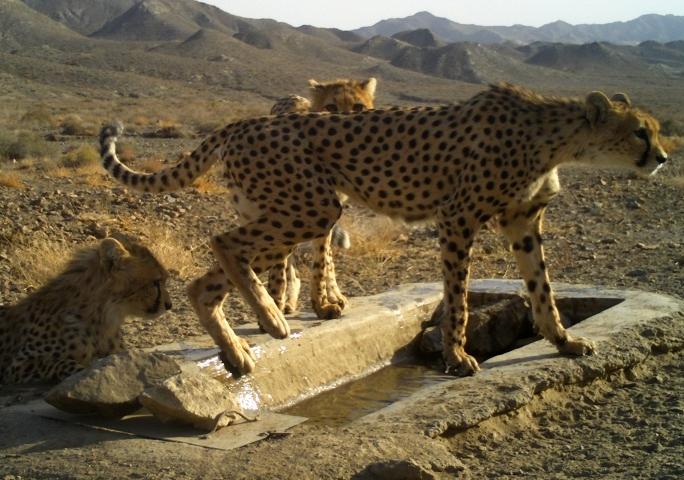Two decades before cheetah translocation from Namibia to Kuno National Park, India’s efforts to clone Asiatic cheetah from Iran had failed after the western Asia country backtracked from the project. Perhaps, it could have saved the species, believed to be on the brink of extinction. Now,only 12 Asian cheetahs are left in Iran and its government termed the situation as “extremely critical.” Compared to African cheetahs, its Asiatic cousin is smaller but has a thicker coat, a more powerful neck, and slender legs. Many experts believe that they could be faster than African species with longer legs, but this theory could not be confirmed in the absence of any test.
The Project Cloning
When cheetahs were released in Kuno, experts considered the presence of leopards as a threat to the cheetahs. But in 2003, the scientists of Hyderabad based Centre for Cellular and Molecular Biology (CCMB) had planned a female leopard as a surrogate mother. However, the Iranians were not prepared to allow export of the animal or its semen which would enable scientists in India to resurrect the cheetah The project to clone the animal, which was first mooted by Laboratory for the Conservation of Endangered Species (LaCONES or CCMB- LaCONES ) , appeared to have had a revival when the then Union minister for forest and environment Jairam Ramesh, said that he was keen on importing cheetah from abroad. The scientists had planned to insert nuclei from cheetah cells into the enucleated ova of a leopard.
Also Read: Cheetahs In Kuno National Park : Future Tense
The centre's cloning project had not made progress during the three years since it was first proposed in the beginning of this century due to non-availability of a live cheetah or its genetic material. A female leopard was to be used as a surrogate , CCMB’s then director Dr Lalji Singh had said. The then Iranian president Mohammad Khatami had even visited the CCMB giving an impression that the project might take off. Lalji Singh had said Khatami heard his plea for Iran's help, made a note of his suggestions in his diary and appeared favourably disposed to the proposal. Besides the joint venture, which would have not entailed any financial commitment on the part of Iran, India had urged Iran to allow a team of CCMB scientists to visit Iran to collect genetic material from cheetahs or bring a pair of live cheetahs. "Even if it is not possible to procure a live cheetah, some live tissues of the animal could do the job," the Indian scientists had said. But Iran did not agree.
Cheetah Cubs in Captivity
Now the animal is on the verge of extinction. Asiatic cheetahs once lived across the grasslands of India, Pakistan, Russia, and the Middle East, but have been entirely wiped out except in Iran. But in Iran too, the situation continues to deteriorate. There were over 100 cheetahs when India-Iran initiated a joint project to save the species. But now .deputy head of natural environment and biodiversity of the department of environment (DOE) Hassan Akbari , was quoted by Tasnim news agency on January 2022 , “there are believed to be only nine male and three female Asiatic Cheetahs in the country, compared to an estimated 100 in 2010.”
Also Read: Cheetahs In Kuno Kill Another Deer But The Real Test Awaits
"The measures we have taken to increase protection, reproduction, and the installation of road signs have not been enough to save this species," he said. Despite Iran’s efforts to raise awareness about the endangered animals, they were killed by farmers, run over by car and even killed by hunters. Many cheetahs had died due to natural calamities also. The Iranian government became the target of a domestic and international outcry when a revolutionary court in November 2019 imprisoned at least six conservation experts who were members of the Persian Wildlife Heritage Foundation, a local group focused on biodiversity protection, especially for Asiatic cheetahs. The environmentalists were accused of spying for the United States and Israel, “seeking proximity to military sites with the cover of the environmental projects and obtaining military information from them.”
Also Read: Why Cheetahs in Kuno National Park Are Linked with International Ivory Trade ?
Miandasht Wildlife Refuge and Touran Biosphere Reserve were the only remaining reproductive Asiatic Cheetah habitats in Iran. Miandasht Wildlife Refuge, with 84,000 hectares, was one of the first areas that the Iranian Cheetah Society (ICS) started working on for conserving the cheetah population. However, it’s been more than two years since there have been any records of cheetah reproduction there. Unlike Miandasht, Touran Biosphere Reserve with 1.5 million hectares is the only remaining area with records of cheetah reproduction nowadays. Recently, ICS released pictures of three cheetah cubs born in captivity in Touran Cheetah Breeding Center. Two of the cubs are female. Cubs are born during a cesarean. All three cubs were reported to be healthy but the mother didn’t accept them yet.
By Deshdeep Saxena
Images: Courtsey: Iranian Cheetah Society




Comments
Post a Comment